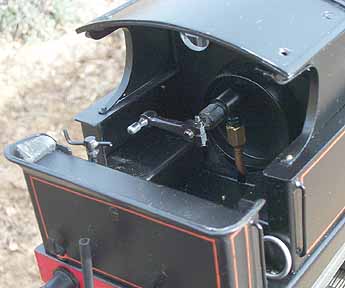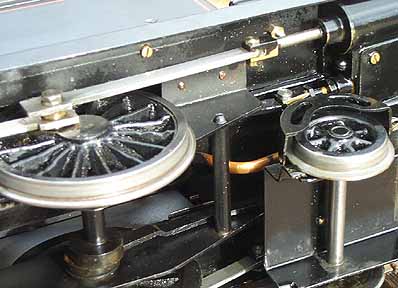
Back to Sidestreet Bannerworks
February 2003
H.B. Models Taff Vale 4-4-0T
by Marc Horovitz

This is a replica of a locomotive that ran on the standard-gauge Taff Vale Railway, a large coal-hauling railway that ran in South Wales from 1841 to 1922, when it became part of the Great Western Railway (GWR). As an interesting aside, I.K. Brunel, the great engineer of the GWR also laid out the Taff Vale.
The model, built by H.B. Models (Harold and Barbara Denyer) of England, is a simply built, smooth-running engine. It's a small engine with large drivers, an unusual combination. The locomotive features an alcohol-fired pot boiler running off a three-wick burner. Meths is stored in the usual place under the footplate. The rectangular wick-feeder tube also provides a little additional storage. The burner must be removed from the engine for filling, as the filler cap is concealed in the bunker when in place. There is a vent tube at the rear, which could be used as a filler, if you are adventurous. Since there's no overflow pipe, there's no way of knowing if you've got enough (or too much) spirit in the tank. The alcohol could overflow, engulfing the engine in a pool of flaming meths, which is something usually to be avoided.
There are two fixed cylinders outside the frames, controlled by D-valves inside. Valve gear is slip eccentrics on the leading, driven axle, so you must first push the engine in the direction you wish it to go to set the valves.
There is a working smokebox door, behind which is the displacement lubricator. You have to stand the engine on its rear end to replace the oil.
Boiler fittings include only a throttle and safety valve. The backhead is very bare, with just the throttle. In some respects, the engine is almost toylike, despite its scale proportions.
The run
One of my personal maxims is "simple is good." There is little that could be simpler about this engine. Stand the engine on end, snap open the smokebox door, and replace the cylinder oil in the lubricator. To fuel it, you remove the burner by withdrawing the pin that clips it in place. Remove the filler cap, top up with alcohol, and clip the burner back in place. Slide off the polished brass dome, remove the generous filler cap, and fill the boiler with distilled water. You're ready to go.
Our run was on a balmy, January day. I placed the engine on the track and lit it up. In five minutes or less steam was up. I open the throttle and the engine was away without so much as a push. With its big drivers, this can be a speedy engine. However, it's easy to throttle down and it runs sedately, even without a train. It will easily pull three or four coaches. The safety valve went off more than I like, suggesting a need to repack the wicks.
This is an unusual locomotive with an uncommon wheel arrangement. It has characteristics that are quintessentially British and it looks wonderful gliding through the countryside. The run lasted about 25 minutes and was a fine way to spend a pleasant, winter afternoon.
|
|
|
| Builder | H.B. Models (England) |
| Date built | circa 1995 |
| Gauge | 45mm (gauge 1) |
| Scale | 1:32 |
| Boiler | Pot |
| Fittings | Safety valve, throttle |
| Fuel | Alcohol |
| Blow-off pressure | 45 psi |
| Cylinders | Two double-acting D-valve |
| Reversing gear | Slip eccentrics |
| Lubricator | Displacement |
| Dimensions | Length, 11-1/8" over end beams; width, 3-3/8"; height, 5-1/4" |






Back to Sidestreet Bannerworks
This page and its contents Copyright Sidestreet Bannerworks, 2003